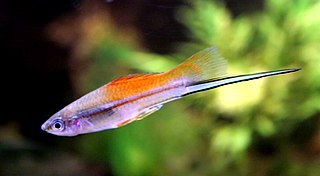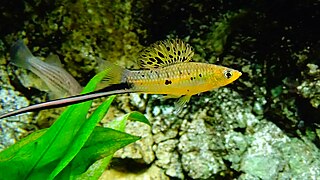
The southern platyfish, common platy, or moonfish is a species of freshwater fish in family Poeciliidae of order Cyprinodontiformes. A live-bearer, it is closely related to the green swordtail and can interbreed with it. It is native to an area of North and Central America stretching from Veracruz, Mexico, to northern Belize.

Xiphophorus is a genus of euryhaline and freshwater fishes in the family Poeciliidae of order Cyprinodontiformes, native to Mexico and northern Central America. Xiphophorus species can be divided into 3 groups based on their evolutionary relationships: platyfish, northern swordtails, and southern swordtails. Platyfish formerly were classified in another genus, Platypoecilus, which is now obsolete. The type species is X. hellerii, the green swordtail. Like most other new world Poeciliids, platies and swordtails are live-bearers that use internal fertilization and give birth to live young instead of laying eggs like the bulk of the world's fishes. The name Xiphophorus derives from the Greek words ξίφος (dagger) and φόρος (bearer), referring to the gonopodium on the males. All are relatively small fishes, which reach a maximum length of 3.5–16 cm (1.4–6.3 in) depending on the exact species involved.

The Monterrey platyfish is a species of freshwater fish in family Poecilidae. A live-bearer, it was native to a very small section of the San Juan River system in the vicinity of the city of Monterrey, Mexico. The specific name refers to the American soldier and naturalist Darius N. Couch (1822–1897) who collected the type on a self financed expedition to Mexico.
The Bavispe sucker, in Mexican matalote del Bavispe, is a species of ray-finned fish in the family Catostomidae. It is found only in Mexico.
The Charco Palma pupfish is a species of small fish in the family Cyprinodontidae. It is endemic to the Ojo de Agua la Presa in southwestern Nuevo Leon state in Mexico. Although listed as critically endangered by the IUCN in 1996, the species is now extinct in the wild. The same freshwater spring system was the home of three other pupfish: Cyprinodon ceciliae (extinct), Cyprinodon inmemoriam (extinct) and Cyprinodon longidorsalis. Although these were from the same spring system, each was restricted to its own individual spring and associated waters. The exact spring and associated waters inhabited by the Charco Palma pupfish were also the home of three now-extinct invertebrates: An undescribed species of Cambarellus crayfish, the valvatid freshwater snail Valvata beltrani and an undescribed species of valvatid freshwater snail. The specific name honours the niece of María de Lourdes Lozano-Vilano and daughter of Salvador Contreras-Balderas, Verónica Contreras Arqueita, who assisted on the trip on which the type was collected.
The yellowfin gambusia is a species of fish in the family Poeciliidae. It is endemic to the Rio Conchos of Chihuahua, Mexico, where it is known as guayacon de san gregorio. This species was described in 1957 by Clark Hubbs and Victor G. Springer with the type locality given as El Ojo de San Gregorio in Chihuahua. The specific name of this fish honours the Mexican ichthyologist José Alvarez del Villar (1903-1986) for his work on the fishes of Mexico and for his assistance to Clark and Springer.
The yellow swordtail is a species of freshwater fish in the family Poeciliidae. It is endemic to the upper Coatzacoalcos River basin in southern Mexico. It is typically found in brooks and streams with slow current; it is less frequent in areas with strong current. The yellow swordtail is considered a threatened species by Mexican authorities. It reaches up to 5.1 cm (2.0 in) in standard length.
The northern platyfish is a small, endangered species of fish in the family Poeciliidae. It is endemic to the vicinity of Cuatro Ciénegas in the Mexican state of Coahuila. It is restricted to hot-spring heated ditches and marshes of the Laguna Santa Tecla. Its native water is shallow and vegetation-choked, with very stable temperatures that generally are around 27–30 °C (81–86 °F), although captive studies show the species also can live in slightly colder water.
The Chiapas swordtail or upland swordtail is a species of livebearing freshwater fish of family Poeciliidae, and genus Xiphophorus. It is, therefore, in the same genus as the common platy and the swordtail. The Chiapas swordtail was discovered and first described by Donn E. Rosen in 1960, along with four other species of Xiphophorus.

The green swordtail is a species of freshwater/brackish fish in family Poeciliidae of order Cyprinodontiformes. A live-bearer, it is closely related to the southern platyfish or 'platy' (X. maculatus) and can crossbreed with it. It is native to an area of North and Central America stretching from Veracruz, Mexico, to northwestern Honduras.

Xiphophorus nigrensis, the Panuco swordtail, is a species of fish in the family Poeciliidae that is endemic to a small part of the Pánuco River basin in Mexico.
Xiphophorus multilineatus is a fish in the family Poeciliidae. It is endemic to a small part of the Pánuco River basin in Mexican.
Xiphophorus mayae is a fish in the family Poeciliidae. It is found in Central America: eastern Guatemala and western Honduras. This species has red lines on its body which extend on to the upper portion of the caudal fin, males have the lower part of the caudal fin extended into a "sword".

Xiphophorus montezumae, the Montezuma swordtail, is a livebearing freshwater fish of the order Cyprinodontiformes, family Poeciliidae, and genus Xiphophorus. It is in the same genus as the common platy and the swordtail. Xiphophorus means 'sword-bearer' in Greek.

Xiphophorus nezahualcoyotl, the mountain swordtail, is a live bearing fish in the family Poeciliidae. It is endemic to the northwestern Pánuco River basin in Mexico. The specific name of this fish refers to the poet, philosopher and emperor of Texcoco, Nezahualcoyotl (1402–1472).
Xiphophorus birchmanni, commonly known as the sheephead swordtail, is a live bearing fish in the family Poeciliidae.

Xiphophorus continens, also known as El Quince swordtail or short-sword platyfish, is a live-bearing freshwater fish in the family Poeciliidae. It is endemic to the Pánuco River basin in east-central Mexico. Its name comes from the Greek conto, meaning short, and Latin ensis, meaning "sword". due to the species' sword size in males.
Xiphophorus malinche, also known as highland swordtail, is a live bearing fish in the family Poeciliidae. It is endemic to the Pánuco River basin in east-central Mexico. This species is named after La Malinche, an Indian slave who played a role in the Spanish conquest as the interpreter, secretary, and mistress of Hernán Cortés.

Xiphophorus pygmaeus, the pygmy swordtail, is a poeciliid fish from northeastern Mexico. It is the smallest of the swordtails. The male's sword is barely visible and the species is often called the swordless swordtail. It is sometimes kept in home aquaria, but is a rather delicate species.









